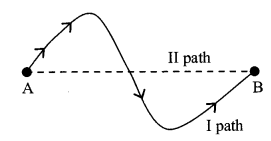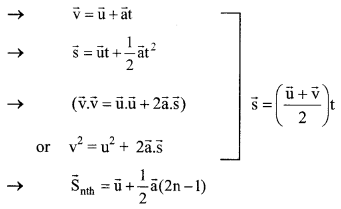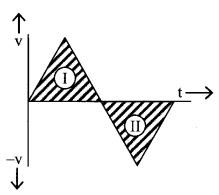Motion in One Dimension Formulas
Wanna solve Motion in One Dimension Related Problems in an easy way? Then, this page is the right one for you as we have mentioned all the Motion in One Dimension Formulas. Try to recall the Complete List of Formulas using the Motion in One Dimension Cheat Sheet. Get to see the formulas related to distance, speed, displacement, velocity, acceleration, and many more. Access our Physics Formulas to get grip on several concepts you might be looking for regarding the subject and enhance your skills.
Formulae Sheet for Motion in One Dimension
1. DISTANCE (s) (Scalar) = Total path cover
Length of path followed by particle = length of I path (See fig.)

2. DISPLACEMENT (r) (Vector) = final position – initial position
Shortest Length of path followed by particle = length of IInd path.
(See. fig.)
3. SPEED (scalar)
1. Instantaneous speed = \(\frac{\mathrm{ds}}{\mathrm{dt}}\)
2. Average speed \(\overline{\mathrm{V}}=\frac{\text { Total dis tan ce }}{\text { Total time }}\)
\(\overline{\mathrm{V}}=\frac{s_{1}+s_{2}+\ldots . s_{n}}{t_{1}+t_{2}+\ldots . t_{n}}=\frac{s_{1}+s_{2}+\ldots s_{n}}{\frac{s_{1}}{V_{1}}+\frac{s_{2}}{V_{2}}+\ldots . . \frac{s_{n}}{V_{n}}}=\frac{V_{1} t_{1}+V_{2} t_{2}+\ldots \ldots . V_{n} t_{n}}{t_{1}+t_{2}+\ldots \ldots \ldots \ldots . t_{n}}\)
- If t1 = t2 = …… = tn; \(\overline{\mathrm{V}}=\frac{V_{1}+V_{2}+\ldots \ldots+V_{n}}{n}\),
for n = 2, \(\overline{\mathrm{V}}=\frac{V_{1}+V_{2}}{2}\) - If s1 = s2 = …….. = sn; \(\bar{V}=\frac{n}{\frac{1}{V_{1}}+\frac{1}{V_{2}}+\ldots \ldots \frac{1}{V_{n}}}\);
in case n = 2 \(\overline{\mathrm{V}}=\frac{2 \mathrm{V}_{1} \mathrm{V}_{2}}{\mathrm{V}_{1}+\mathrm{V}_{2}}\)
4. VELOCITY \(\overrightarrow{\mathrm{V}}\) (vector)
1. Instantaneous velocity = \(\frac{\overrightarrow{\mathrm{dr}}}{\mathrm{dt}}\)
2. Average velocity = \(\frac{\text { Total displacement }}{\text { Total Time }}=\frac{\overrightarrow{\mathrm{r}}_{2}-\overrightarrow{\mathrm{r}}_{1}}{\mathrm{t}_{2}-\mathrm{t}_{1}}=\frac{\Delta \overrightarrow{\mathrm{r}}}{\Delta t}\)
= \(\left|\vec{V}_{a v}\right|\) Γëñ \(\overline{\mathrm{V}}\)
5. FOR UNIFORM MOTION
- Distance= speed × time
- Displacement = velocity × time
FOR UNIFORM ACCELERATION WHEN \(\overrightarrow{\mathbf{a}}\) = CONST.

u → initial velocity, v → final velocity,
a → acceleration, s → displacement
Note:- Motion under gravity
v = u – \(\frac{1}{2}\)gt2
v2 = u2 – 2 gh
hnth = u – \(\frac{1}{2}\) g(2n – 1)
(i) If a particle is thrown vertically upwards with initial velocity u then equation of motion becomes
- Maximum height attained by the particle = \(\frac{u^{2}}{2 g}\)
- Time to reach maximum height = \(\frac{\mathrm{u}}{\mathrm{g}}\)
- Time of flight = \(\frac{2 u}{g}\)
(ii) If a particle is thrown vertically downwards with initial velocity u then equation of motion becomes
v = u + gt
y =ut+ \(\frac{1}{2}\) gt2
v2 = u2 + 2 gy
ynth = u+ \(\frac{1}{2}\)g(2n – 1)
6. ACCELERATION
1. Instantaneous acceleration
\(\overrightarrow{\mathrm{a}}=\frac{\mathrm{d} \overrightarrow{\mathrm{v}}}{\mathrm{dt}}=\frac{\mathrm{d}^{2} \overrightarrow{\mathrm{r}}}{\mathrm{dt}^{2}}, \overrightarrow{\mathrm{a}}=\frac{\overrightarrow{\mathrm{v}} \overrightarrow{\mathrm{dv}}}{\mathrm{ds}}\)
2. Average acceleration
\(\vec{a}=\frac{\text { net change in velocity }}{\text { total time }}=\frac{\Delta \overrightarrow{\mathrm{v}}}{\Delta \mathrm{t}}=\frac{\overrightarrow{\mathrm{v}}_{2}-\overrightarrow{\mathrm{v}}_{1}}{\mathrm{t}_{2}-\mathrm{t}_{1}}\)
7. DISTANCE COVERED
S = \(\int_{t_{1}}^{t_{2}}\)v dt = Area under the v – t curve and t axis, (see fig.)

→ distance = Area I + Area II
ΓåÆ displacement = Area I – Area II
- If acceleration (a) is the function of time then
Change in velocity = v2 – v1 = \(\int_{v_{1}}^{v_{2}}\) dv = \(\int_{t_{1}}^{t_{2}}\) adt = Area under the a – t curve and t axis. - If acceleration (a) is the function of position (x) then
\(\int_{v_{1}}^{v_{2}}\)vdv = \(\int_{x_{1}}^{x_{2}}\)adx
Take help from Physicscalc.Com and get different concepts formulas that you might need as a part of your work or assignments.